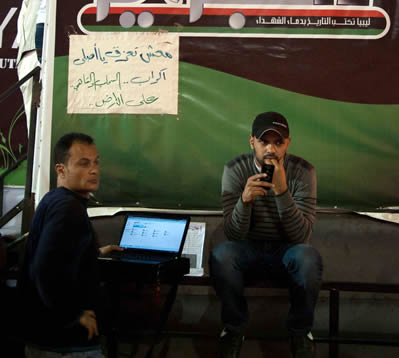Libya is Back Online! Sort Of?

So first and foremost: this was not a social media revolution. This is just your friendly recap of what’s known of network connectivity in Libya during the past six months. Oh--and hai! I'm back.
A few months ago, a member of the NDI Middle East team walked into our office and asked how difficult it would be to wire downtown Benghazi.
She had just returned from eastern Libya and observed a need. Enterprising engineers had rigged a VSAT connection, turning the square in front of Benghazi’s main courthouse—the original site of the protests that would launch a revolution—into a public hotspot. People would cluster around laptops, waiting patiently on the shared network, scanning for updates from friends and family in the Ghaddafi-controlled west, or comparing official news against frantic rumor.
The answer was that wiring a city wouldn’t actually be that difficult in theory. In practice, it’s not exactly NDItech’s bread and butter (although I certainly offered to be on a plane that evening). Shortly thereafter, the question was mooted—the Libyans had restored Benghazi’s connectivity on their own.
However, access to the Internet remained hobbled over the past few months, with Tripoli almost entirely dark. Then, Monday night, as history rolled into the capital in pickup trucks filled with jubilant rebel fighters, the city unexpectedly came back online. Tripoli residents silenced by a months-long shutdown of Internet service emerged—expressing doubt, then wonder—then disappearing altogether as they left their computers for the celebration in the streets. This morning, it seems the networks were down again.
The question is—why?
Learning from Egypt, the Libyan government shut down connectivity to the Internet in early February, reproducing the offlline result—though using different tactics. Rather than disconnect from the global network, Libya killed last-mile access, leaving the lights on for some (presumably government subscribers) while ‘throttling [connectivity] to the point of uselessness’ for the vast majority.
This sometimes made for inconsistent understandings of events on the ground, and almost certainly contributed to Libya’s disappearance from the news for much of the time between March and this recent late-August surge.
In Tripoli, blogs like the pro-Gaddafi S.O.S. Libya remained online, fueling speculation they were the work of a Gaddafi electronic army. Following an August diktat that anyone found with a satellite phone would be executed for war crimes, it seems likely these sources had tacit backing. In the east, NTC supporters found themselves couriering news across the Egyptian border to upload.
Despite the drama of the web throttle, the real story from Libya was the mobile network shutdown—and reclamation—in the east. Internet penetration in Libya hovers around only 5% of the population, but mobile subscriptions are reported at a stunning 170% of the population.
In mid-February, in a presumable effort to undermine coordination among the anti-Ghaddafi opposition, mobile networks went down in Benghazi. Mobile had been a critical channel for the NTC and rebel forces, operating along vast front-line expanses. As satellite phone signals were jammed, fighters were reduced to operating with hand signals and semaphore. Scarcity pushed the cost of a SIM card in Benghazi pushed upwards of $115.
Then, in mid-April, news broke that engineers had nicked the eastern GSM network from under the regime's nose. Accounts differ, but it appears employees of the Libyana network brought domestic services back online, while a Libyan-American telecom executive secured a donation of routing equipment from the UAE-based Etilsalat and convinced Egyptian customs to expedite processing. Within days, 700,000 subscribers—and NTC operations—were back on the international grid.
Access has been bumping along ever since, with voice services as the primary channels between East and West. Interestingly, the engineering of the Free Libyana network restoration meant that all eastern network traffic was unencrypted, but evidence has yet to emerge that the regime was intercepting traffic in any systematic way.
Of course, none of this answers the question of why the Internet flickered back to life in Tripoli Monday night. Some speculated it was a reverse Mubarak, a bread-and-circuses attempt to prevent people from heading into the streets (or, as Renesys put it, encourage them to catch up on five months of back email). Unlikely.
So, was it sympathetic network engineers? And why did connectivity drop only hours after being restored? On August 21st, the homepage of Libya Telecom & Technology was reportedly scrolling “Congratulations, Libya, on emancipation from the rule of the tyrant,” but when I checked it just now (August 22nd), the feed carried the far more measured “Libya, one tribe united.”
Certainly, here’s to a united Libya—and an eventual unraveling of this (admittedly, relatively minor) mystery.
Also, thanks to Renesys for the best coverage of Libyan Internet.
